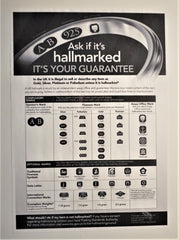A hallmark is an official mark or a series of marks that are applied to items made of metal to indicate the amount of pure metal that is in the alloy. Hallmarking was introduced by Edward 1st who passed a statute requiring all silver to be assayed (tested) and marked with a leopard’s head.
The wardens of the Goldsmiths Guild were designated this responsibility of marking all sterling silver items. Traditionally they were applied by striking with a punch but these days they can be lasered on.
The first hallmarking was done in London but over time other offices were opened.

The full traditional hallmark consists of five marks:
Sponsor’s mark- This is the registered mark of the sponsor or maker of the piece. Each one is unique. It is formed of initials of the person or company inside a shield shape.
Traditional fineness mark- This mark shows the precious metal content of the object and that it is no less than indicated. It is an optional part of a hallmark but the London Assay office apply it as standard.
Millesimal fineness mark- The shape of the shield indicates the metal type. In the gold mark 375 is 9 carat, 585 is 14 carat, 750 is 18 carat and 916 is 22 carat. In the silver mark 925 is sterling and 958 is Britannia silver.
Assay office mark- This shows which office the piece was tested at.
Date mark- The font, case and shape of the shield change each year on January 1st. At the end of the year all the punches are destroyed. This is another mark that is not compulsory to have but is useful as it is an easy way to date an item.
Jewellery did not have to be hallmarked prior to 1973. A law was brought in ensuring that, from this date, all items of gold, silver and platinum must be hallmarked to confirm that they meet the legal standard.







